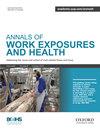198 Conceptualization and construction of a low-cost and self-made device for monitoring of particulate matter
IF 2.1
4区 医学
Q3 PUBLIC, ENVIRONMENTAL & OCCUPATIONAL HEALTH
引用次数: 0
Abstract
Introduction The aim of this study is to present a step-by-step process that walks through the conceptualization and building of a low-cost (~ $150) monitoring device for airborne fine particulate matter (PM2.5), based on miniaturized sensors and components. Methodology Details on the implementation of the hardware and software are provided which facilitate the data acquisition and analysis. The central components and their setup discussed in what follows include: the sensor device (called “P.ALP” – Ph.D. Air quality Low-cost Project), Arduino IDE (Integrated Development Environment) and R code (open-access software). The devices were tested for accuracy and precision under controlled conditions (type of dust, dust concentrations, temperature, relative humidity) using an aerosol testing chamber (Marple design). Results A monitoring device for PM2.5, based on low-cost sensors and technologies was successfully conceptualized, designed, and implemented. The preliminary tests showed promising results in detecting dust concentration variability and satisfying performances in terms of data storage and operating time. Conclusions The P.ALP monitoring system was designed and developed to be a basic device, which can be further customized and implemented using the wide range of low-cost sensors available on the market.198 构想和制造低成本自制颗粒物监测装置
引言 本研究的目的是介绍一个逐步的过程,通过概念化和构建一个基于微型传感器和组件的低成本(约 150 美元)空气中细颗粒物(PM2.5)监测装置。方法论 详细介绍了硬件和软件的实施,这有助于数据采集和分析。下文讨论的核心部件及其设置包括:传感器设备(称为 "P.ALP"--博士空气质量低成本项目)、Arduino IDE(集成开发环境)和 R 代码(开放获取软件)。利用气溶胶测试室(Marple 设计)在受控条件(粉尘类型、粉尘浓度、温度、相对湿度)下对设备的准确性和精确度进行了测试。结果 成功构思、设计和实施了基于低成本传感器和技术的 PM2.5 监测设备。初步测试表明,该设备在检测粉尘浓度变化方面取得了可喜的成果,在数据存储和运行时间方面的表现也令人满意。结论 P.ALP 监测系统的设计和开发是为了使其成为一个基本设备,可以利用市场上广泛的低成本传感器对其进行进一步定制和实施。
本文章由计算机程序翻译,如有差异,请以英文原文为准。
求助全文
约1分钟内获得全文
求助全文
来源期刊

Annals Of Work Exposures and Health
Medicine-Public Health, Environmental and Occupational Health
CiteScore
4.60
自引率
19.20%
发文量
79
期刊介绍:
About the Journal
Annals of Work Exposures and Health is dedicated to presenting advances in exposure science supporting the recognition, quantification, and control of exposures at work, and epidemiological studies on their effects on human health and well-being. A key question we apply to submission is, "Is this paper going to help readers better understand, quantify, and control conditions at work that adversely or positively affect health and well-being?"
We are interested in high quality scientific research addressing:
the quantification of work exposures, including chemical, biological, physical, biomechanical, and psychosocial, and the elements of work organization giving rise to such exposures;
the relationship between these exposures and the acute and chronic health consequences for those exposed and their families and communities;
populations at special risk of work-related exposures including women, under-represented minorities, immigrants, and other vulnerable groups such as temporary, contingent and informal sector workers;
the effectiveness of interventions addressing exposure and risk including production technologies, work process engineering, and personal protective systems;
policies and management approaches to reduce risk and improve health and well-being among workers, their families or communities;
methodologies and mechanisms that underlie the quantification and/or control of exposure and risk.
There is heavy pressure on space in the journal, and the above interests mean that we do not usually publish papers that simply report local conditions without generalizable results. We are also unlikely to publish reports on human health and well-being without information on the work exposure characteristics giving rise to the effects. We particularly welcome contributions from scientists based in, or addressing conditions in, developing economies that fall within the above scope.
 求助内容:
求助内容: 应助结果提醒方式:
应助结果提醒方式:


